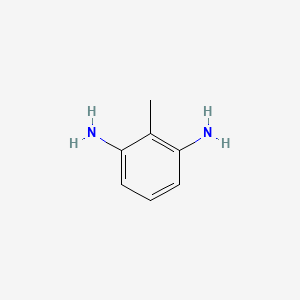D0656 | 2,6-toluenediamine
| Toxicity | Dose | Time | Species | Model | Method | Action | Positive criterion | Reference |
|---|---|---|---|---|---|---|---|---|
| MEMBRANE POTENTIAL | 15.70±10.03 | human | qHTS-HepG2 | MMP assay | decrease | IC50 | 163 | |
| MEMBRANE POTENTIAL | 28.18 | human | HepG2 | MMP assay | decrease | IC50 | 163 | |
| MEMBRANE POTENTIAL | 32.18±7.36 | rat | hepatocytes | MMP assay | decrease | IC50 | 163 | |
| Pictogram | Signal | Statements | Precautionary Statement Codes |
|---|---|---|---|
   |
Warning |
H302: Harmful if swallowed [Warning Acute toxicity, oral] H312: Harmful in contact with skin [Warning Acute toxicity, dermal] H317: May cause an allergic skin reaction [Warning Sensitization, Skin] H341: Suspected of causing genetic defects [Warning Germ cell mutagenicity] H411: Toxic to aquatic life with long lasting effects [Hazardous to the aquatic environment, long-term hazard] |
P201, P202, P261, P264, P270, P272, P273, P280, P281, P301+P312, P302+P352, P308+P313, P312, P321, P322, P330, P333+P313, P363, P391, P405, and P501; (The corresponding statement to each P-code can be found at the GHS Classification page.) |
   |
Warning |
Aggregated GHS information provided by 161 companies from 4 notifications to the ECHA C&L Inventory. Each notification may be associated with multiple companies. H302 (100%): Harmful if swallowed [Warning Acute toxicity, oral] H312 (100%): Harmful in contact with skin [Warning Acute toxicity, dermal] H317 (100%): May cause an allergic skin reaction [Warning Sensitization, Skin] H341 (100%): Suspected of causing genetic defects [Warning Germ cell mutagenicity] H411 (100%): Toxic to aquatic life with long lasting effects [Hazardous to the aquatic environment, long-term hazard] Information may vary between notifications depending on impurities, additives, and other factors. The percentage value in parenthesis indicates the notified classification ratio from companies that provide hazard codes. Only hazard codes with percentage values above 10% are shown. |
P201, P202, P261, P264, P270, P272, P273, P280, P281, P301+P312, P302+P352, P308+P313, P312, P321, P322, P330, P333+P313, P363, P391, P405, and P501; (The corresponding statement to each P-code can be found at the GHS Classification page.) |
   |
Warning |
H302: Harmful if swallowed [Warning Acute toxicity, oral] H312: Harmful in contact with skin [Warning Acute toxicity, dermal] H317: May cause an allergic skin reaction [Warning Sensitization, Skin] H341: Suspected of causing genetic defects [Warning Germ cell mutagenicity] H411: Toxic to aquatic life with long lasting effects [Hazardous to the aquatic environment, long-term hazard] |
P201, P202, P261, P264, P270, P272, P273, P280, P281, P301+P312, P302+P352, P308+P313, P312, P321, P322, P330, P333+P313, P363, P391, P405, and P501; (The corresponding statement to each P-code can be found at the GHS Classification page.) |
  |
Warning |
H315: Causes skin irritation [Warning Skin corrosion/irritation] H319: Causes serious eye irritation [Warning Serious eye damage/eye irritation] H335: May cause respiratory irritation [Warning Specific target organ toxicity, single exposure Respiratory tract irritation] H336: May cause drowsiness or dizziness [Warning Specific target organ toxicity, single exposure Narcotic effects] H361: Suspected of damaging fertility or the unborn child [Warning Reproductive toxicity] H371: May cause damage to organs [Warning Specific target organ toxicity, single exposure] |
P201, P202, P260, P261, P264, P270, P271, P280, P281, P302+P352, P304+P340, P305+P351+P338, P308+P313, P309+P311, P312, P321, P332+P313, P337+P313, P362, P403+P233, P405, and P501; (The corresponding statement to each P-code can be found at the GHS Classification page.) |
| (3-amino-2-methyl-phenyl)amine | 1,3-Benzenediamine, 2-methyl- | 2, 6-Diaminotoluene |
| 2, 6-Tolylenediamine | 2,6-DAT | 2,6-DIAMINOTOLUENE |
| 2,6-Diamino toluene | 2,6-Diamino-1-methylbenzene | 2,6-Diaminotoluene, 97% |
| 2,6-Diaminotoluene, 98% | 2,6-Toluenediamine | 2,6-Toluylenediamine |
| 2,6-Tolylenediamine | 2-Methyl-1,3-benzenediamine | 2-Methyl-1,3-benzenediamine (ACD/Name 4.0) |
| 2-Methyl-1,3-phenylenediamine | 2-Methyl-m-phenylenediamine | 2-Methyl-m-phenylenediamine, analytical standard |
| 2-methylbenzene-1,3-diamine | 3-13-00-00291 (Beilstein Handbook Reference) | 71K; |
| 823-40-5 | 823D405 | A840303 |
| AC-11513 | ACMC-209pob | ACT07296 |
| AKOS004910550 | ANW-37545 | BDBM74255 |
| BRN 2079476 | CAS-823-40-5 | CCRIS 3031 |
| CHEBI:76288 | CHEMBL1489438 | CTK3E9114 |
| D0124 | DB-027657 | DSSTox_CID_7319 |
| DSSTox_GSID_27319 | DSSTox_RID_78404 | DTXSID4027319 |
| EINECS 212-513-9 | FT-0610534 | H838Q10551 |
| HSDB 4131 | InChI=1/C7H10N2/c1-5-6(8)3-2-4-7(5)9/h2-4H,8-9H2,1H | KS-00000X7U |
| KSC449C1J | LS-1820 | MCULE-3706030536 |
| MFCD00007800 | MLS002174248 | NCGC00090710-01 |
| NCGC00090710-02 | NCGC00257679-01 | NCI-C50317 |
| NSC 147490 | NSC-147490 | NSC147490 |
| Q1987204 | RLYCRLGLCUXUPO-UHFFFAOYSA-N | RTR-025750 |
| SBB061338 | SC-13648 | SCHEMBL30289 |
| SMR001261423 | ST24040884 | ST51047362 |
| STR07388 | TR-025750 | TRA0093697 |
| Toluene, 2,6-diamino- | Toluene-2,6-diamine | Tolylene-2,6-diamine |
| Tox21_200125 | UNII-H838Q10551 | UNII-NJX12DY6BY component RLYCRLGLCUXUPO-UHFFFAOYSA-N |
| VZ22842 | ZINC388289 | cid_13205 |
| o-Toluene diamine |

